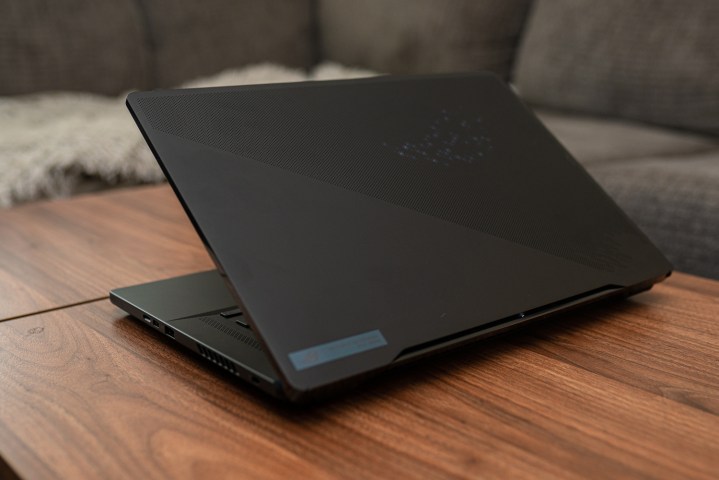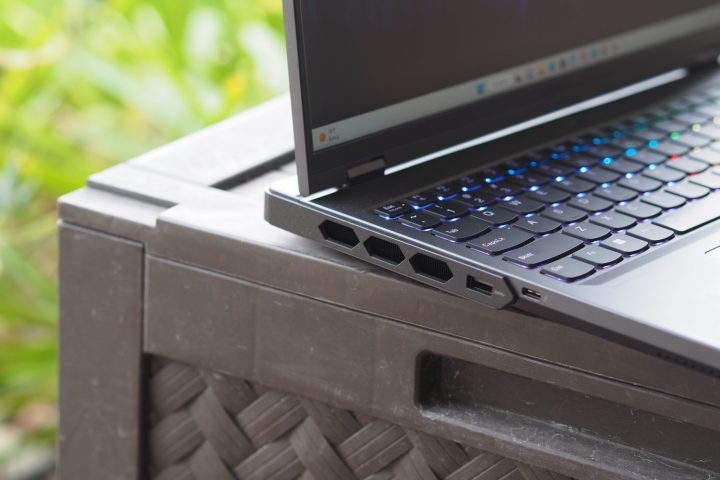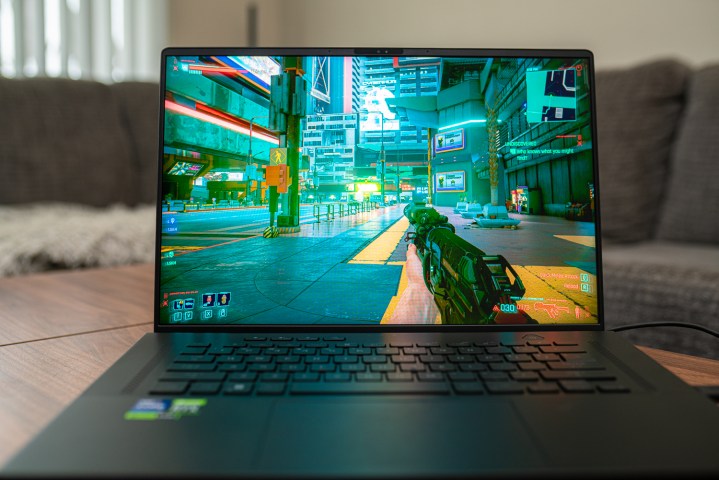New gaming laptops are arriving with Intel’s latest 13th-gen CPUs and Nvidia’s latest 4000 series GPUs. The Asus ROG Zephyrus M16 and Lenovo Legion Pro 7i are two such machines, each bringing their strengths.
The Lenovo has a much faster CPU, for example, while the Asus sports the latest in gaming display technology, mini-LED. Both are excellent gaming laptops that can keep up with modern titles at 1440p with all features turned on. But which is the best for you?

Specs and configurations
| Lenovo Legion Pro 7i | ROG Zephyrus M16 2023 | |
| Dimensions | 14.3 inches x 10.32 inches x 0.86 – 1.01 inches | 13.98 inches x 9.70 inches x 0.88 inches |
| Weight | 6.17 pounds | 4.6 pounds |
| Processor | Intel Core i9-13900HX | Intel Core i9-13900H |
| Graphics | Nvidia GeForce RTX 4080 | Nvidia GeForce RTX 4070 Nvidia GeForce RTX 4080 Nvidia GeForce RTX 4090 |
| RAM | 32GB DDR5-6000MHz | Up to 64GB DDR5-4800 |
| Display | 16.0-inch 16:10 QHD+ (2,560 x 1,600) IPS, 240Hz | 16.0-inch 16:10 QHD+ (2,560 x 1,600) IPS, 240Hz 16.0-inch 16:10 QHD+ mini-LED, 240Hz |
| Storage | 1TB PCIe 4.0 SSD | Up to 2TB PCIe 4.0 SSD Additional SSD slot |
| Ports | 4 x USB-A 3.2 Gen 1 1 x USB-C 3.2 Gen 2 1 x USB-C with Thunderbolt 4 1 x HDMI 2.1 1 x Ethernet RJ45 1 x 3.5mm audio jack |
1 x USB-C 3.2 Gen 2 1 x USB-C Thunderbolt 4 2 x USB-A 3.2 Gen 1 1 x HDMI 2.1 1 x 3.5mm audio jack 1 x microSD card slot |
| Wireless | Wi-Fi 6E and Bluetooth 5.1 | Wi-Fi 6E and Bluetooth 5.3 |
| Webcam | 1080p | 1080p with IR camera for Windows 11 Hello |
| Operating system | Windows 11 | Windows 11 |
| Battery | 99.9 watt-hours | 90 watt-hour |
| Price | $2,750 | $1,950+ |
| Rating | 4 out of 5 stars | 4.5 out of 5 stars |
The Asus ROG Zephyrus M16 comes in several configurations, starting at $1,950 with an Intel Core i9-13900H, 16GB of RAM, a 1TB SSD, a 16.0-inch QHD+ IPS display, and an Nvidia GeForce RTX 4070. You can spend up to $3,500 for the same CPU, 32GB of RAM, a 2TB SSD, a 16.0-inch QHD+ mini-LED display, and an RTX 4090. The Lenovo Legion Pro 7i has just one configuration. It’s $2,750 for a Core i9-13900HX, 32GB of RAM, a 1TB SSD, a 16.0-inch QHD+ IPS display, and an RTX 4080.
You can buy an ROG Zephyrus M16 for less than the Legion Pro 7i, but you’re getting lesser components. You can also spend more on the Asus, but as we’ll see in our performance section, you’re not getting more speed for the extra money, but you are getting a spectacular display.
Design

Neither laptop has a distinctly gamer-oriented chassis. The Legion Pro 7i is fairly unremarkable, with an all-black chassis that looks a lot like any other 16-inch laptop. Its nod to the gamer aesthetic comes from its per-key RGB keyboard lighting and an RGB “U” light strip running across the front bottom of the chassis. This lights up the surface and adds a splash of color. The ROG Zephyrus M16 is a sleeker machine that looks better overall, but it doesn’t have a distinctly gamer chassis either. Its one standout aesthetic feature is the AniMe LED matrix on the lid, with 18,170 holes that make a surface for creating animations, displaying text, and flashing in time with audio. Of the two, the Asus is more modern and attractive.
The ROG Zephyrus M16 is also quite a bit smaller in width and depth, and it’s thinner and lighter than the Legion Pro 7i. Most notably, it’s just 4.6 pounds compared to the Lenovo’s 6.17 pounds. Both laptops are made of machine aluminum and so both are solidly built. The ROG Zephyrus M16 has a hinge that angles the keyboard a bit when opened, improving airflow underneath the chassis. That also keeps it quieter when running full-blast compared to the somewhat noisier Legion Pro 7i.
The Legion Pro 7i uses Lenovo’s Legion TrueStrike keyboard that offers good travel and a stiff actuation that’s nice for gaming and not quite as comfortable for regular typing. It offer’s 100% anti-ghosting to make for accuracy during intense gaming sessions. The ROG Zephyrus M16’s keyboard uses a membrane keyboard that it shares with earlier Zephyrus gaming machines, with 1.7mm of travel (that’s a lot) to make for satisfying key mashing while gaming. It’s a comfortable keyboard for regular typing as well. The Asus also has a larger touchpad, which makes for more comfortable gaming if you’re not using an external gaming mouse.
Connectivity is similar between the two laptops, with both offering a mix of USB-C with Thunderbolt 4 and old-school USB-A ports. The biggest difference is that the Legion Pro 7i has an Ethernet port that the ROG Zephyrus M16 l lacks, while the latter features an microSD card reader. Both utilize the latest in wireless connectivity.
Both laptops also sport 1080p webcams, which makes each one ideal for videoconferencing. Asus includes an infrared camera for Windows 11 Hello passwordless login support, while you get no biometric login with the Legion Pro 7i, which I consider an oversight.
Performance

The ROG Zephyrus M16 is built around a 13th-gen 45-watt Intel Core i9-13900H, a 14-core (six Performance and eight Efficient), 20 thread CPU running at 5.4GHz on the Performance cores and 4.1GHz on the Efficient cores. The Legion Pro 7i ups that to the 55-watt Core i9-13900HX, a 24-core (eight Performance and 16 Efficient), 32-thread processor at 5.4GHz and 3.9GHz.
Our benchmark results were mixed between the two. While the Asus kept up in our Handbrake test that encodes a 420MB video as H.265, it fell well behind in Cinebench R23. The Legion Pro 7i also was much faster in the PugetBench Premiere Pro benchmark, which runs in a live version of Adobe’s Premiere Pro video-editing application. Premiere Pro can make use of the GPU to speed up specific processes, so the Lenovo’s performance is even more impressive given that it was equipped with an RTX 4080 compared to the Asus’s RTX 4090.
Both laptops are incredibly fast for productivity and creative workflows. But the Legion Pro 7i is even quicker.
| Lenovo Legion Pro 7i (Core i9-13900HX) |
Asus ROG Zephyrus M16 (Core i9-13900H) |
|
| Handbrake (seconds) |
Bal: 55 Perf: 51 |
Bal: 59 Perf: 58 |
| Cinebench R23 (single / multi) |
Bal: 2,096 / 22,596 Perf: 2,046 / 28,263 |
Bal: 2,058 / 17,511 Perf: N/A |
| Pugetbench Premiere Pro | Bal: 1,310 Perf: 1,441 |
Bal: 1,100 Perf: N/A |
Regarding gaming performance, the Legion Pro 7i once again held its own even with a slower GPU. As we noted in our ROG Zephyrus M16 review, the RTX 4090 might be too much GPU for this particular design, and it showed in our benchmarks. When comparing performance modes, the Legion Pro 7i virtually matched the Asus across all our gaming benchmarks. Both can play modern titles at 144op with graphics turned up, and the Legion is the more impressive given its components and price.
| Lenovo Legion Pro 7i (Nvidia GeForce RTX 4080) |
Asus ROG Zephyrus M16 (Nvidia GeForce RTX 4090) |
|
| 3DMark Time Spy | Bal: 12,874 Perf: 18,071 |
Bal: 14,421 Perf: 18,372 |
| Cyberbunk 2077 (1080p Ultra) |
Bal: 114 fps Perf: 113 fps |
Bal: 92 fps Perf: 109 fps |
| Assassin’s Creed Valhalla (1080p ULtra High) |
Bal: 125 fps Perf: 129 fps |
Bal: 116 fps Perf: 136 fps |
| Red Dead Redemption 2 (1440p Ultra) |
Bal: 71 fps Perf: 99 fps |
Bal: 80 fps Perf: 99 fps |
Display

The Legion Pro 7i has one display option, a 16.0-inch 16:10 QHD+ (2,560 x 1,600) IPS panel running at 240Hz. It’s a fine display, with premium average colors (with superior accuracy), tons of brightness, and a good contrast ratio. Its fast 240Hz refresh rate means you’ll enjoy tear-free gaming.
But the ROG Zephyrus M16 has a phenomenal display option, which we tested: a 16.0-inch 16:10 QHD+ mini-LED screen also running at 240Hz. It’s incredibly bright, making it excellent for high dynamic range (HDR) content, has colors wide and accurate enough for all but the most demanding creators, and enjoys deep contrast that rivals OLED in producing inky blacks.
Asus enjoys a runaway win in the display shootout. The move toward mini-LED in gaming laptops is a great one, and the ROG Zephyrus M16 is one of the first machines to offer it.
| Lenovo Legion Pro 7i (IPS) |
Asus ROG Zephyrus M16 (mini-LED) |
|
| Brightness (nits) |
529 | 870 |
| AdobeRGB gamut | 77% | 90% |
| sRGB gamut | 100% | 100% |
| Accuracy (DeltaE, lower is better) |
0.62 | 1.4 |
| Contrast ratio | 1,140:1 | 20,000:1 |
Portability

Although both laptops are based around 16-inch 16:10 displays, the ROG Zephyrus M16 is smaller, thinner, and lighter than the Legion Pro 7i. Neither can be considered thin and light laptops, but the Asus manages is a lot more portable than Lenovo’s machine.
Neither laptop is meant to be used without a charger, and it shows. They lasted a few hours in our suite of battery benchmarks, and that’s running relatively lightweight productivity tasks. Try to game without being plugged in, and not only will your performance suffer, but you’ll get no more than a couple of hours out of them. And that’s OK.
Conclusion
The Legion Pro 7i is less expensive than the ROG Zephyrus M16, but it’s also less configurable. You get a faster CPU for your money, but a slower GPU — on paper, anyway. In fact, the cheaper Lenovo is just as fast as the costlier Asus in gaming, and it’s a much faster productivity and creativity workstation.
At the same time, the ROG Zephyrus M16 offers a mini-LED display option that’s simply spectacular. It truly improves the gaming experience, and it’s worth the money. If you want the absolute fastest between the two, then by all means select the Lenovo. But the Asus’ display is enough to win over many users.



